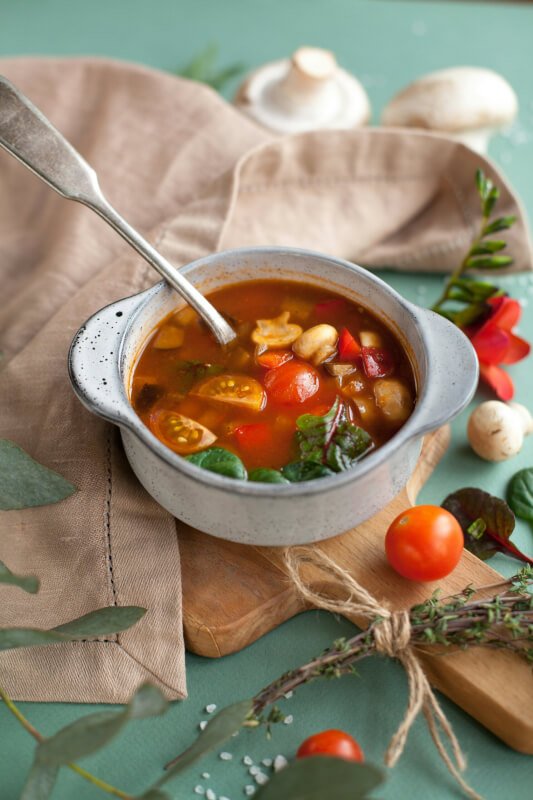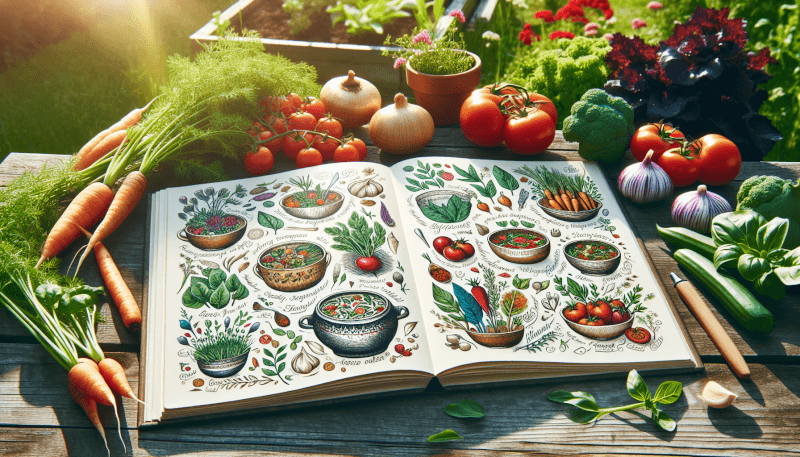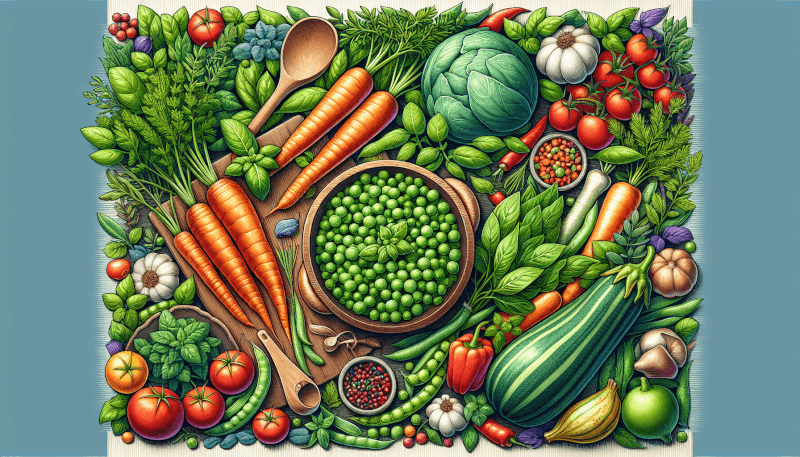Looking for delicious and nutritious recipes that make the most of your garden harvest? Look no further! This article is here to help you discover a variety of mouthwatering soups and stews that will leave you feeling satisfied and nourished. From vibrant vegetable soups bursting with flavor to hearty stews packed with protein, we’ve got you covered. So grab your apron and get ready to embark on a culinary journey that celebrates the bounty of your garden. These recipes are sure to please your taste buds and keep you warm all season long.

Choosing and Preparing Vegetables
Selecting Fresh Vegetables
When it comes to making delicious soups and stews, choosing fresh vegetables is essential. Look for vegetables that are firm, with vibrant colors and smooth skin. Avoid any vegetables that are wilted, bruised, or have soft spots. It’s also important to consider the seasonality of vegetables to ensure optimal flavor and nutritional value. Visit your local farmer’s market or grocery store that sources from local farms for the freshest options.
Cleaning and Cutting Vegetables
Before using your vegetables, it’s crucial to clean them thoroughly. Rinse them under running water to remove any dirt or residue. For leafy greens, like spinach or kale, separate the leaves and soak them in a bowl of water to remove any hidden dirt. After cleaning, it’s time to cut the vegetables. Use a sharp knife and a cutting board to slice, dice, or chop them according to your recipe’s requirements. Remember to keep the sizes uniform to ensure even cooking.
Blanching for Better Taste
Blanching is a technique used to enhance the flavor and texture of vegetables. It involves briefly boiling the vegetables and then quickly transferring them to an ice bath to stop the cooking process. Blanching helps to retain the vibrant colors of vegetables while also removing any bitterness. It is especially beneficial for vegetables like broccoli, carrots, and green beans. To blanch vegetables, bring a pot of salted water to a boil, add the vegetables, and cook them for a few minutes until they become bright and slightly tender. Then, transfer them to a bowl of ice water for a few seconds before draining them. This technique will ensure that your soups and stews have the best flavor and texture.
Basic Soup and Stew Recipes
Classic Vegetable Soup
A classic vegetable soup is a comforting and nutritious choice for any meal. To make this soup, start by sautéing aromatic vegetables like onions, carrots, and celery in a large pot. Once the vegetables are soft and fragrant, add vegetable broth and a variety of chopped vegetables such as potatoes, tomatoes, peas, and corn. Season with herbs like thyme, bay leaves, and parsley, and let the soup simmer until the flavors meld together. Serve it hot with a sprinkle of fresh herbs on top for added freshness.
Hearty Lentil Stew
Lentil stew is not only hearty and satisfying, but it’s also packed with protein and fiber. In a large pot, sauté onions and garlic until fragrant. Then, add dried lentils, diced tomatoes, and vegetable broth. This stew can be customized with your choice of vegetables like carrots, celery, and bell peppers. Add herbs and spices such as cumin, coriander, and smoked paprika for extra depth of flavor. Let the stew simmer until the lentils are tender and the flavors are well combined. Serve it piping hot with a side of crusty bread for a complete and wholesome meal.
Chunky Tomato Soup
Chunky tomato soup is a simple yet flavorful option that highlights the natural sweetness of tomatoes. Start by sautéing onions and garlic in a pot until they turn translucent. Then, add diced tomatoes, vegetable broth, and a touch of tomato paste for added richness. Season with herbs like basil and oregano, and let the soup simmer until the flavors meld together. For a chunky texture, you can add diced vegetables like carrots, zucchini, and bell peppers. Finish with a swirl of cream or a sprinkle of Parmesan cheese for a luxurious touch.
Adding Protein to Your Soups and Stews
Incorporating Beans and Legumes
Beans and legumes are a fantastic source of protein and fiber, making them a great addition to soups and stews. Whether you prefer black beans, chickpeas, or lentils, they add a hearty texture and richness to any dish. You can either use canned beans, which are convenient and time-saving, or cook dried beans beforehand for an extra flavor boost. Rinse and drain the beans before adding them to your soups and stews to remove any excess sodium or starchy liquid. They will not only elevate the nutritional value of your dish but also make it more filling and satisfying.
Including Lean Meats and Poultry
To add a dose of animal protein to your soups and stews, lean meats and poultry are a great option. Choose cuts of meat that are tender and relatively low in fat, such as chicken breasts, turkey tenderloins, or lean beef. Brown the meat in a pan before adding it to the pot of simmering soup or stew, as this will enhance the flavor and create a rich base. Make sure to remove any excess fat and skin to keep the dish healthy. The meat will become tender and juicy as it cooks with the other ingredients, providing a satisfying and hearty addition to your meal.
Introducing Plant-Based Proteins
If you follow a vegetarian or vegan diet, there are plenty of plant-based protein options to incorporate into your soups and stews. Tofu, tempeh, and seitan are excellent choices that can mimic the texture and taste of meat. They can be marinated and sautéed before adding to the dish, or simply simmered in the broth to absorb the flavors. Another great source of plant-based protein is edamame, which adds a pleasant crunch and vibrant color to your soups and stews. These plant-based proteins provide the necessary nutrients while keeping your meal wholesome and satisfying.
Enhancing Flavor with Herbs and Spices
Fresh Herbs for Depth of Flavor
Fresh herbs are an excellent way to elevate the taste and aroma of your soups and stews. Herbs like basil, thyme, rosemary, and parsley add freshness and complexity to your dishes. Add them towards the end of the cooking process to preserve their delicate flavors. You can either chop them finely and sprinkle them on top of each serving or tie them together with kitchen twine to create a bouquet garni, which can be easily removed before serving. Experiment with different herb combinations to develop your own unique flavor profile and take your soups and stews to the next level.
Spices for Warmth and Complexity
Spices are another essential component when it comes to enhancing the flavor of your soups and stews. Common spices like cumin, paprika, turmeric, and cinnamon can add warmth and depth to your dishes. Toasting whole spices before grinding them can intensify their flavors and release their aromatic oils. This can be done by heating them in a dry skillet over medium heat until they become fragrant. Just a pinch of the right spices can transform a simple soup or stew into a culinary masterpiece, so don’t be afraid to experiment and find your favorite combinations.
Experimenting with Unique Flavors
Adding unique flavors to your soups and stews can elevate them to a whole new level of deliciousness. Think outside the box and experiment with ingredients like miso paste, coconut milk, or even a splash of balsamic vinegar. Miso paste adds a rich umami flavor, while coconut milk creates a creamy and tropical twist. Balsamic vinegar provides a tangy and slightly sweet note that balances out the flavors. Don’t be afraid to step out of your comfort zone and try something new – you might discover a flavor combination that becomes a family favorite.

Creating Creaminess and Thickness
Using Dairy or Dairy Alternatives
To create a creamy and indulgent texture in your soups and stews, dairy products like milk, cream, or cheese can be added. Whether you prefer whole milk or low-fat options, incorporating dairy can add a velvety smoothness to your dish. For a healthier alternative, you can use unsweetened almond milk or coconut milk, which will still provide a creamy texture without the extra calories. Be sure to add these ingredients towards the end of the cooking process to prevent curdling, and stir gently as they heat through.
Creamy Plant-Based Soups
For those following a vegan or dairy-free diet, there are several plant-based options to create a creamy texture in your soups and stews. One popular choice is using cashews. Soak raw cashews in water for a few hours, then blend them with a little water or vegetable broth until smooth. This cashew cream can be added to your soups and stews to thicken and create a luscious texture. Other alternatives include blending silken tofu, avocado, or cooked white beans, which all contribute to a luxurious creaminess without the need for dairy.
Thickening with Grains and Potatoes
Grains and potatoes are excellent natural thickeners that can add body and texture to soups and stews. Options like barley, quinoa, or rice can absorb the liquid and release starches as they cook, resulting in a thicker consistency. Simply add them to your soup or stew and let them simmer until fully cooked. Potatoes, whether diced or mashed, can also lend a creamy thickness to your dish. They will break down and release starches as they cook, contributing to a hearty and satisfying texture. Experiment with different grains and potatoes to find the perfect level of thickness for your soups and stews.
Maximizing Nutritional Value
Using Homemade Vegetable Broth
One way to maximize the nutritional value of your soups and stews is by using homemade vegetable broth. Commercially prepared broths often contain added sodium and other preservatives, while homemade broth allows you to control the ingredients and flavors. Collect vegetable scraps like onion skins, carrot peels, and celery leaves and store them in the freezer until you have enough to make a batch of broth. Simmer the scraps with water, herbs, and spices for an hour or two, then strain out the solids. The result is a flavorful, low-sodium broth that adds depth and nutrition to your soups and stews.
Adding Superfoods for Boosted Nutrition
Superfoods are nutrient-dense ingredients that can be added to your soups and stews to enhance their nutritional value. Ingredients like kale, spinach, and Swiss chard are packed with vitamins and minerals and can be added towards the end of the cooking process for a burst of freshness and color. Other superfoods to consider include quinoa, chia seeds, and turmeric. Quinoa is a complete protein and adds texture to your dish, while chia seeds provide omega-3 fatty acids and a gelatinous quality. Turmeric, with its anti-inflammatory properties, adds a vibrant yellow hue and earthy flavor to your soups and stews.
Retaining Nutrients through Cooking Methods
To retain the maximum amount of nutrients in your soups and stews, it’s important to choose cooking methods that preserve the nutritional value of the ingredients. Steaming and blanching vegetables before adding them to your soups can help to lock in their vitamins and minerals. Avoid overcooking vegetables to prevent nutrient loss – they should be tender but still vibrant in color. Furthermore, using minimal liquid and cooking at low heat for an extended period can help to preserve nutrients. Simmering your soups and stews gently will maintain the flavors and nutritional benefits of the ingredients.

Adapting Recipes for Dietary Restrictions
Gluten-Free and Grain-Free Options
For those following a gluten-free or grain-free diet, there are plenty of options to adapt soup and stew recipes. Instead of using traditional wheat-based noodles or barley, choose gluten-free alternatives like rice noodles, gluten-free pasta, or quinoa. These substitutions will still provide a satisfying texture without the gluten. For a grain-free option, consider using cauliflower rice or spiralized vegetables like zucchini or sweet potato. These swaps will add bulk and nutrition to your soups and stews without the grains.
Dairy-Free and Vegan Choices
To make your soups and stews dairy-free and vegan-friendly, there are a variety of substitutions available. Instead of using cow’s milk or cream, opt for unsweetened almond milk, coconut milk, or cashew cream. These plant-based alternatives will provide creaminess without compromising on taste or texture. Replace butter with olive oil, coconut oil, or dairy-free margarine to maintain the richness in flavor. Additionally, omitting meat and poultry and incorporating plant-based proteins like tofu, tempeh, or legumes will make your soups and stews suitable for vegans.
Low-Sodium and Heart-Healthy Variations
If you’re looking to reduce your sodium intake or create heart-healthy soups and stews, there are simple adjustments you can make to the recipes. Choose low-sodium broths or make your own using reduced-sodium ingredients. Use herbs, spices, and fresh vegetables to enhance the flavors instead of relying on salt. Consider using lean cuts of meat or poultry to reduce saturated fat, or choose plant-based proteins for a heart-healthy option. Adding plenty of vegetables and whole grains will increase fiber content and overall nutritional value, making your dishes wholesome and heart-smart.
Soup and Stew Garnishes
Crunchy Toppings for Texture
Garnishing your soups and stews with crunchy toppings not only adds texture but also provides a delightful contrast to the softness of the dish. Croutons, whether store-bought or homemade, are a classic choice that adds a satisfying crunch. Toasted nuts like almonds, walnuts, or pine nuts can also be sprinkled on top for an extra bite. For a healthier option, try adding a handful of crispy roasted chickpeas or seeds like pumpkin or sunflower seeds. These garnishes will transform your soups and stews into a multi-textured experience.
Fresh Citrus for Brightness
To brighten the flavors of your soups and stews, consider adding a splash of fresh citrus juice or zest just before serving. Squeezing a wedge of lemon, lime, or orange into the dish can provide a burst of tanginess that balances out the richness. Citrus zest, grated finely from the skin of the fruit, adds a fragrant and aromatic element. Both techniques will awaken your taste buds and lift the overall flavor profile of the dish. It’s a simple and refreshing way to bring a touch of brightness to your soups and stews.
Creamy Sauces and Drizzles
For a luxurious finishing touch, creamy sauces or drizzles can be added to your soups and stews. A dollop of sour cream, yogurt, or crème fraîche on top of a hot bowl of soup creates a velvety richness that melts into the dish as you stir. Alternatively, you can make a quick herb-infused oil by blending fresh herbs like basil, cilantro, or parsley with olive oil. Drizzle it over the soup just before serving to add a burst of flavor and elegance. These creamy sauces and drizzles will elevate your soups and stews to a gourmet level.

Freezing and Storing Soups and Stews
Proper Containers and Packaging
To ensure that your soups and stews stay fresh and flavorful, it’s important to store them properly. Use containers that are specifically designed for freezing, such as freezer-safe plastic containers or glass jars with airtight lids. Leave some headspace in the containers to allow for expansion as the soup freezes. Alternatively, you can use freezer bags, removing as much air as possible before sealing. Label each container with the name of the soup or stew and the date it was prepared for easy reference.
Storage Duration and Guidelines
Most soups and stews can be stored in the freezer for up to three months without compromising the taste and texture. However, it’s best to consume them within one to two months for optimal quality. When it’s time to enjoy the frozen soup or stew, thaw it overnight in the refrigerator before reheating. For safety reasons, avoid thawing at room temperature. Once thawed, heat the soup or stew on the stovetop or in the microwave until it reaches a safe serving temperature, ensuring that it is piping hot all the way through.
Tips for Reheating
When reheating your frozen soups and stews, there are a few tips to keep in mind to maintain the best quality. For stovetop reheating, place the soup or stew in a pot over medium heat, stirring occasionally to prevent scorching. If using a microwave, transfer the soup or stew to a microwave-safe dish and cover it loosely to retain moisture. Reheat in short intervals, stirring in between, until the desired temperature is reached. Remember to check for any cold spots before consuming. To refresh the flavors, you can add a splash of broth, herbs, or spices while reheating.
Creative Soup and Stew Recipes
Roasted Vegetable and Quinoa Stew
This roasted vegetable and quinoa stew combines the flavors and textures of roasted vegetables and protein-packed quinoa. Start by roasting a variety of vegetables like butternut squash, bell peppers, and eggplant in the oven until caramelized and tender. In a large pot, sauté onion, garlic, and spices for depth of flavor. Add vegetable broth, diced tomatoes, and cooked quinoa to the pot, along with the roasted vegetables. Let the stew simmer until all the flavors meld together. Serve it garnished with fresh herbs and a squeeze of lemon juice for a refreshing finish.
Coconut Curry Lentil Soup
For a taste of exotic flavors, this coconut curry lentil soup is sure to satisfy. In a large pot, sauté onions, garlic, and curry paste until fragrant. Add lentils, diced tomatoes, vegetable broth, and coconut milk to create a luscious and creamy base. The lentils will cook and become tender as they simmer with the aromatic ingredients. You can customize the spiciness level by adjusting the amount of curry paste. Serve it hot with a sprinkle of fresh cilantro for a pop of freshness and a side of naan bread for dipping.
Mexican Corn Chowder
This Mexican corn chowder brings together the flavors of corn, spices, and creamy goodness. In a pot, sauté onions, garlic, and bell peppers until softened. Add corn kernels, vegetable broth, diced tomatoes, and spices like cumin and paprika for a burst of flavor. Simmer the chowder until the corn is tender and the flavors combine. For added creaminess, you can blend a portion of the chowder and return it to the pot. Serve it hot with a dollop of sour cream and a sprinkle of chopped cilantro for a taste of Mexico in a bowl.
Nourishing soups and stews are a great way to incorporate an abundance of vegetables, proteins, herbs, and spices into your diet. By choosing and preparing fresh vegetables, adding protein, enhancing flavors, creating creaminess, maximizing nutrition, adapting for dietary restrictions, garnishing thoughtfully, and properly storing your creations, you can enjoy delicious and nourishing soups and stews all year round. So gather your ingredients, grab your favorite pot, and get ready to create comforting and healthy meals that warm the soul.



